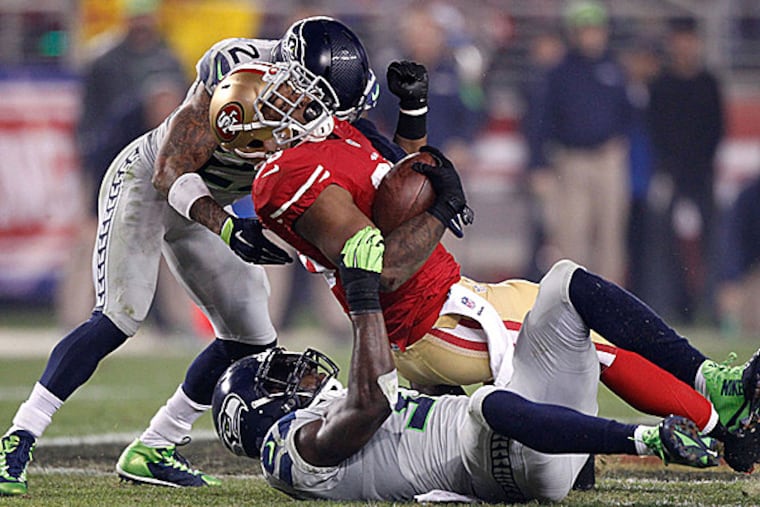Seattle's Legion of Boom will test Eagles passing game
Chip Kelly and Pete Carroll may not seem much alike on the surface. Kelly has an East Coast edge. Carroll is California cool. Kelly is offensive minded. Carroll has 40 years of experience as a defensive coach.

Chip Kelly and Pete Carroll may not seem much alike on the surface. Kelly has an East Coast edge. Carroll is California cool. Kelly is offensive minded. Carroll has 40 years of experience as a defensive coach.
But they do share one coaching trait - aside from being successful at the highest levels of football - and that is having a core philosophy, making it work, and maintaining belief even when things fall apart.
Carroll believes in playing an attacking brand of defense and has since the 1970s when he worked under Monte Kiffin at Arkansas. The Seahawks coach has had many coaching lives in college and the NFL, but he has essentially stuck to his defensive beliefs.
And the culmination has come in Seattle with the league's most talented secondary - the "Legion of Boom," as it is known - and a cover scheme that gives Carroll and defensive coordinator Dan Quinn enough flexibility to attack up front.
"Yeah, they've done the same thing since Pete's been there," said Kelly, who faced the Seahawks coach when he was at Oregon and Carroll was at Southern Cal. "They've got the personnel."
Richard Sherman leads the way. He is arguably the NFL's best cover cornerback. Just ask him. The former Stanford wide receiver wasn't drafted until the fifth round in 2011, but Carroll saw a rangy (6-foot-3, 195-pound) defender who could run with and contain the league's increasing number of tall receivers.
No other cornerback in the league has been targeted less, according to Pro Football Focus, but Sherman still has three interceptions this season, including two last week against the 49ers.
"He's got 23 picks since 2011 - eight more than any other player in the league - and there's a reason for that. He's a smart player, he's an intelligent player," Kelly said. "He's big, he's physical, and he's got great ball skills."
Safety Earl Thomas is the linchpin in center field. He covers more grass than a mower. He can play closer to the box, but his counterpart at safety, Kam Chancellor, is more of a quasi-linebacker. Byron Maxwell is the other cornerback and often sees the bulk of opponents' outside passes playing opposite Sherman.
He moves into the slot in the Seahawks' nickel package and Tharold Simon takes his place on the outside.
The Seahawks play about 60 percent man and 40 percent zone defense, according to Kelly. The defensive backs have the cover skills to play man-to-man, but Carroll's base zone - the Cover 3 - has been particularly effective over the last three years. Seattle has been ranked third, first, and sixth during that span.
Cover 3 - or the three-deep zone - has three defensive backs dropping back and dividing the field into thirds. Typically, the two outside cornerbacks and a safety over the top split the deep zone and four defenders drop and cover underneath. The remaining four players rush the quarterback.
It is a rudimentary zone used at all levels of football and one that isn't difficult for NFL quarterbacks to attack. But Carroll can get away with employing it so often because he has the aforementioned talent and a few wrinkles that allow him to disguise his scheme.
Sherman and Thomas are the keys to making it work. Carroll often has his outside cornerbacks playing man-press on straight routes as part of their Cover 3 responsibilities. Sherman is so good at bottling up receivers that quarterbacks often shy away from throwing at him on the right, thus taking one side of the field away.
"If you spend too much time worrying about one guy," Eagles quarterback Mark Sanchez said, "[you forget] they have so many playmakers."
Eagles receiver Jeremy Maclin will see plenty of Sherman.
Thomas, meanwhile, covers so much ground that Carroll can utilize Chancellor closer to the box to help against the run. Both are interchangeable, however. With an extra defender in the box, Carroll can employ his 4-3 "under" front, which allows most of the linemen to penetrate in one gap.
One lineman will often play two-gap, but Chancellor or a linebacker also can handle the unaccountable run gap that comes from having aggressive, penetrating linemen. The Seahawks give multiple looks up front and in the secondary, but the 4-3 "under" and the Cover 3 have long been staples of Carroll's defense.
Sanchez and Eagles backup quarterback Matt Barkley, who played under Carroll and against his defense in college, said they have seen carryover on film. Sanchez said the coverages are more difficult to identify now because the Seahawks "try to make a lot of things look the same."
Barkley said Carroll remains steadfast in not allowing big passing plays. The Seahawks have allowed only 26 passing plays over 20 yards, which is lowest in the league.
The Eagles are second in the NFL in passing plays over 20 yards with 51. Kelly, who attended Carroll's Seahawks practices when he was at Oregon, knows what the Eagles are up against.
"They've got really, really good players and Pete puts them in position to make plays," Kelly said. "It will be the best secondary that we play."
@Jeff_McLane